Another CNE wildlife special.
Cambodia is home to a large number of mammal species. In the first installment of Cambodian Critters, we look at the smaller furry ones including squirrels, loris and unusual rodents.
The northern smooth-tailed treeshrewDendrogale murina is the smallest of 19 species in the order Scandentia.

The head-body length is 11.5 cm, with a tail length of 4 to 5 cm, weighing in at approximately 35 to 55 g. They are light in color and have facial markings, which are used to distinguish between the other smooth-tailed shrew (Dendrogale melanura), which lacks these facial markings.The upper body is brown/blackish in color, while the underside is lighter. They are short-haired and lack shoulder stripes. The tail is dark and becomes increasingly darker as it nears the tip. This species has relatively small claws
Dendrogale murina tend to breed when fruiting of local trees and shrubs is at its maximum. Their weaning time is about 30 days and they usually give birth to twins. Infant Northern Smooth-tailed Tree Shrews are born weighing 6 to 10 g and are hairless, blind, and totally dependent on the mother. The mother lactates from just two nipples. The mother’s milk is very high in fat content. On average a pair of these shrews mate and produce young every 45 days. Dendrogale murina reach sexual maturity after 2 months. Once sexual maturity has reached, the young are forced out of the nest; they live on their own until they find a suitable mate.
In captivity D. murina live 9 to 10 years, but in the wild they can live to a little over 12 years.
Northern tree shrews (Tupaia belangeri) are found in South East Asia and are native to Bangladesh, Bhutan, Cambodia, China, Laos, Malaysia, Myanmar, Thailand and Vietnam.

Northern tree shrews inhabit a variety of forest habitats. They live in tropical and subtropical areas, which are usually moist environments. They have also been recorded in shrub lands and artificial plantations and rural gardens. Tree shrews inhabit areas about 25 degrees Celsius, with at least 45 to 50% humidity.
Northern tree shrews have a mass of approximately 50 to 270 grams, Head to Body Length of 12 to 21 cm and a tail length ranging from 14 to 20 cm, usually close to the length of their body.
Shrew body temperature has been described, ranging from about 35 degrees Celsius to 40 degrees Celsius; this 5 degree difference is much larger than most endothermic animals (Fuchs and Corbach-Sohle, 2009).
Northern tree shrews have a monogamous mating system. Males and females become sexually reproductive around the same time. Males will be active between four and five months and females can give birth to their first litter at approximately 4 months old.
Immediately after birth the mother will nurse her pups and thereafter only return to feed her young once every 48 hours. They receive approximately 5 to 10 milliliters of milk, with a relatively high fat content of about 25%. Pups consume this amount of milk in approximately 2 to 10 minutes. As a result pups have less than 2 hours contact with their mother during the 30 to 35 day period. Martin (1990) described that as the lowest mother to infant contact and smallest parental investment for viviparous mammals described thus far. Males are not involved in parental care after copulation
Tupaia belangeri has attained growing interest for use as a medical model. In 2002, an article was published describing that they could be used as a model for studying the Hepatitis C virus, which is a major cause of chronic hepatitis worldwide.
Many studies have been done regarding eye structure, development, and vision using the Tupaia belangeri because of the similarity to human eye structure and sight that is uncharacteristic of conventional small lab animals, such as rodents.
The Bengal slow loris (Nycticebus bengalensis) or northern slow loris
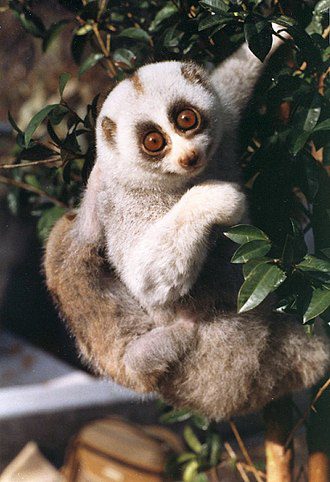
Bengal slow lorises are endemic to the forested areas of south-eastern Asia, including the seven north-eastern states of India (Assam, Arunachal Pradesh, Mizoram, Nagaland, Meghalaya, Manipur, and Tripura) as well as areas of Cambodia, Burma, Thailand, Vietnam, and southern regions of China.
Bengal slow lorises are nocturnal and arboreal members of strepsirrhines. They prefer areas of high canopy cover and forest edges, where insects are more abundant.
They inhabit tropical and sub-tropical rainforests as well as semi-evergreen rainforests in southeastern Asia year round. However, with increasing destruction of their habitat due to deforestation and development of land, they are forced to live in scrub forest.
Bengal slow lorises prefer larger and taller trees with deeper crowns that are associated with higher food abundance as well as a dense micro-habitat that provides protection from predators. They prefer older and younger plantation forests to primary forests.
Bengal slow lorises are the largest of all of the slow lorises, with a skull length of 65.25 mm, larger than any other species of loris. They are heavier than all other loris species with a mass between one and two kg and a length of 26 to 38 cm, being more than three times the weight of the smallest loris, Nycticebus pygmaeus. Bengal slow loris fur patterns differ from other slow lorises which allow for visual differentiation from other species. They have thick, wooly fur with a white head, neck, and underside and a brown-grey dorsal side accompanied by a slight darker brown dorsal stripe running down the back.
These loris practice ‘infant parking,’ where they leave their young hanging from a tree while they go off to feed. Infants are able to be parked on the day of birth. Young are covered in exudates from their mother’s brachial gland in order to protect them from predators. If an infant calls to the mother while parked, the mother will immediately return. Slow loris mothers and their infants have a close attachment from the time of birth, sometimes continuing through their lifetimes.
They carry their young on their backs for as long as three months after birth. They spend a large amount of time play-wrestling and socializing with their mothers as well as other adults once a few months old. Fathers are absent after copulation and do not contribute to parental care. Infants can be weaned at 6 months, but will continue nursing until they reach sexual maturity.
Lorises rarely exhibit aggression towards one another and usually live in family groups. Although some individuals are solitary, most live in a social setting. There is no dominance hierarchy in social groups. They travel 20 to 30 meters each night, either alone or in pairs. They often sleep in tree holes or dense vegetation, sometimes with other lorises, and may occupy up to 60 tree holes throughout their lifetime. They are tolerant of other loris species as they have been observed foraging on the same tree within meters of pygmy slow lorises.
Bengal slow lorises use crypsis to prevent predator detection and often take cover in dense vegetation. When under attack by a predator, Bengal slow lorises roll up in a defensive posture with the brachial glands on the inside of their elbows over their heads to combine the brachial gland exude with saliva. This is applied to the head for defense and is likely foul-tasting. They also bite in defense using their procumbent teeth which can deliver this saliva into the predator. Humans can have allergic reactions to this substance because it is similar in structure to Fel-d1, also known as cat allergen. This can cause anaphylactic shock in humans and other predators.
The most severe threats facing the species are the wildlife trade (trapping for exotic pets and use in traditional medicine) and deforestation. Slash and burn agriculture has also resulted in the destruction of its habitat, and road construction is another factor in its decline.
The animal is predominantly used to prepare treatments for women after childbirth, stomach problems, healing wounds and broken bones, and in the treatment of sexually transmitted diseases. Primary users are wealthy to middle-class women in urban areas.
Pygmy slow lorises, Nycticebus pygmaeus, are found in Vietnam, Laos, eastern Cambodia, and neighboring regions of southern China (southeast Yunnan province).
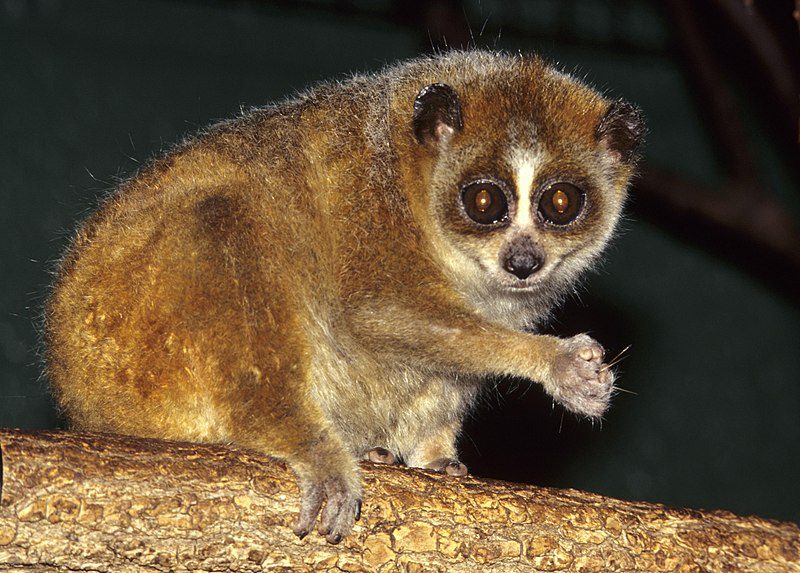
Locals in the Mondulkiri province suggest that pygmy slow lorises prefer thick, complex forested areas with bamboo to dry dipterocarp forest, and observations confirm their preference of mixed deciduous to semi-evergreen forests. Individuals of this species are usually seen at heights of 3 to 12 m in the canopy.
Zoologist J.L. Harrison describes pygmy slow lorises as “rather like a child’s teddy-bear.”
Pygmy slow lorises measure 15 to 25 cm in length and weigh from 120 to over 500 g (average 400 g). Males are generally larger than females.
Pygmy slow lorises produce a toxin from modified sweat glands located near their elbows. They have been observed licking theses glands when alarmed. Their bite can be dangerous to humans; the only account of a pygmy slow loris biting a human resulted in an adult woman entering anaphylactic shock.
Because pygmy slow lorises have only rarely been studied in the wild, many aspects of their behavior are still unknown. In captivity, pygmy slow lorises are capable of reproduction as old as 14 years of age. They have been known to live 20 years in captivity.
Pygmy slow lorises are commonly used in medicines in Cambodia. In Phnom Penh, they are found in local markets roasted, dried, and made into pre-mixed medicines with rice-wine, alcohol, honey, or charcoal. Doctors of traditional medicine reported in questionnaires that these medicines are primarily used to treat “women after childbirth, stomach problems, wounds, broken bones, and sexually transmitted diseases”. In the 1950s the fur of slow lorises was used to dress wounds and cuts because of its blood clotting properties, and it may still be used as such in some localities. Some researchers attribute the popularity of loris medicine to the lack of access to or education about biomedical alternatives and high levels of poverty.
Due to increased protection of this species, market price is increasing. Veteran hunters able to distinguish different species of loris and know species distributions in local forests yield high profits. Trade is driven by wealthy city dwellers who are able and willing to pay rural hunters for their illegal product.
Live trade of slow lorises occurs in high levels in the Mondulkiri, Ratanakiri, and Phnom Penh provinces of Cambodia. As many as 204 lorises were found in a single store in Phnom Penh. Slow lorises are the most popular pets that are listed on CITES Appendix I.
The black giant squirrel or Malayan giant squirrel (Ratufa bicolor)
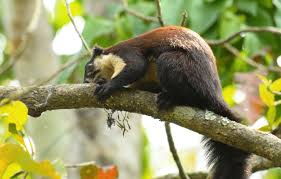
Black giant squirrels are characterized by their distinct size and fur. With a weight of up to 1.5 kg and lengths of 80 cm from head to tail, black giant squirrels are one of the largest members of the squirrel family.
They are identifiable by their black fur, tan chest patch and occasionally tan tail tip. Unlike many squirrels, black giant squirrels do not have a tail that curls over its back. Instead, their tail lays limp behind them.
The average lifespan for black giant squirrels is 18 years in captivity. There are very few records detailing the lifespan of black giant squirrels all of which have been collected from captive, wild-born specimens.
Black giant squirrels are diurnal and known for their tendency to make its nests in the canopy of tall trees. Like most tree squirrels they are a solitary animals, although they occasionally are seen in groups or pairs during the breeding season.
Black giant squirrels will forage on the ground for fruit and nuts extending their range below their normal habitat in the canopy.
Because of their affinity for fruit and nuts black giant squirrels disperse seeds of large-seeded tree species.
Black giant squirrels are susceptible to hunting and deforestation. they are in decline mainly due to over-hunting and secondarily due to habitat loss and have a Near Threatened status.
Finlayson’s squirrel or the variable squirrel (Callosciurus finlaysonii) is found in Cambodia, Laos, Myanmar, Thailand, and Vietnam. The species occurs in a wide range of wooded habitats, including gardens and parks in cities.
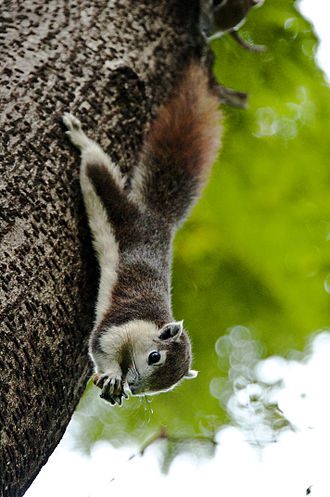
Finlayson’s squirrels are native to central Indochina from central Myanmar southeast through much of Thailand, Laos, and Cambodia to the Mekong Delta in South Vietnam.
The Finlayson’s squirrel has a head-and-body length of about 21–22 cm and its tail is about 22–24 cm long. They spend most of their time in trees and are rarely seen on the ground.
Limited information is available for the lifespan of Finlayson’s squirrels. In captivity, they are known to survive a maximum of 12.8 years. There is currently no record of the lifespan of the species in the wild.
These squirrels were introduced to Italy, and are popular as pets.
The Cambodian striped squirrel (Tamiops rodolphii or Khmer:កង្ហិច)
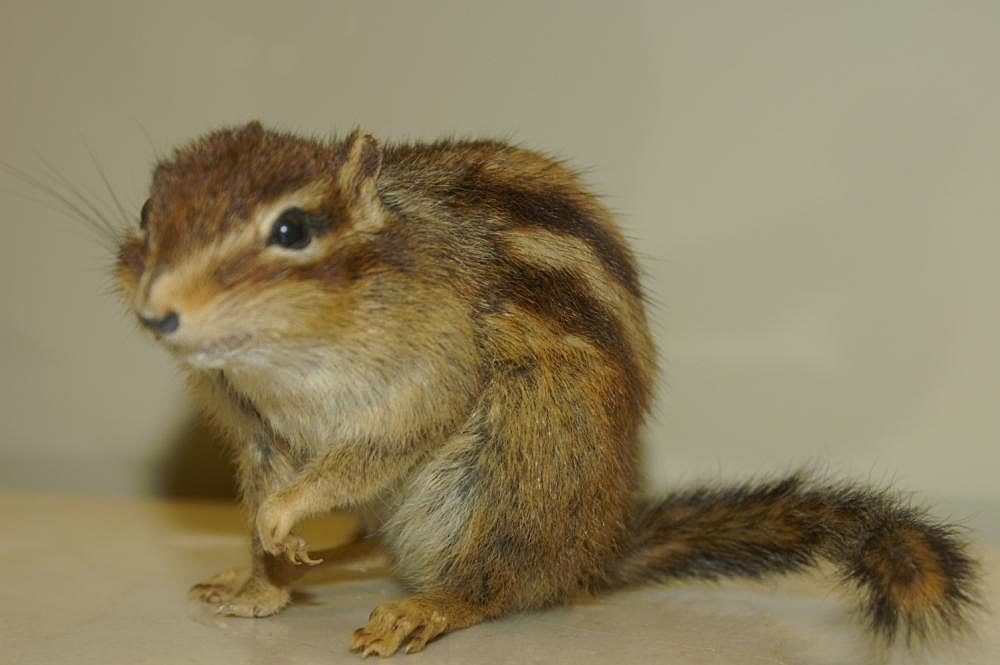
The Cambodian Striped Squirrel inhabits a variety of wooded habitats including thick forest, secondary scrub and gardens.
The species can be identified by the four cream stripes which extend from the back of the neck to the base of the tail. The stripes are all of similar thickness and colour, and between the stripes the fur is dark brown. In some populations the central dark stripe has a thin, pale brown line in the middle.
The head and body length reaches 12 cm, with a tail around the same. The Cambodian striped squirrel weighs up to 56 g.
The flanks and tail are greyish brown, and the head slightly reddish brown to yellowish brown. The belly is pale orange.
The species has been documented in southern Vietnam as an ‘habitual bark gleaner’, meaning that it specializes in feeding intensively on tree bark. It will also consume insects and other invertebrates closely associated with tree bark.
The Berdmore’s ground squirrel (Menetes berdmorei) is a ground squirrel found in Southeast Asia, from the east of Myanmar to Vietnam. It is however absent on the Malay peninsula, as well as the islands.
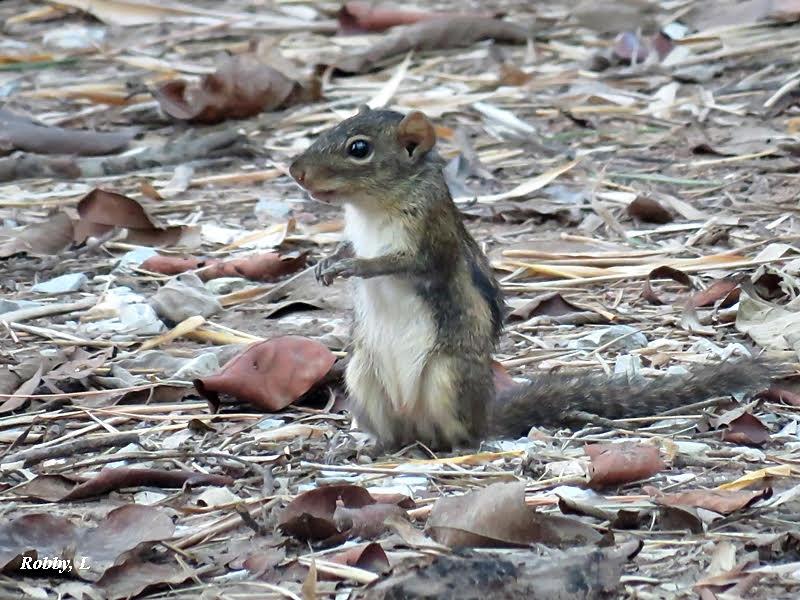
The common, but little studied squirrel has a grey-brown back and a white belly. Most striking are stripes on the side – on each side one beige and below a black stripe. The head is pointy, so this squirrel resembles a mouse or a treeshrew. Its length is 20 cm, not including the 15 cm long tail.
As a ground squirrel it is rarely found on trees, but spends most of the time in the thick underwoods of the rainforests. However it is also found in fields or villages, especially in rice fields it is sometimes omnipresent. Despite it being quite common only very little is known about the life of this squirrel. Despite its name, it is not a close relative of the ground squirrels of the type Marmotini.
The lesser bamboo rat (Cannomys badius) is found in Nepal, northern and eastern Bangladesh, northern Cambodia, northern Vietnam, Bhutan, Assam, southwestern Yunnan, Burma, Thailand, and Laos.

Cannomys badius inhabit thicket and bamboo forests and hilly mountainous regions and are sometimes found at high elevations.
The lesser bamboo rat is a burrowing animal usually found in bamboo groves in mountainous areas, but also occurring in woodland, plantations, and disturbed ground. The burrow entrance may be at the foot of a tree, under a clump of bamboo, in a bank, or in the open. Excavated earth is flung up in a mound at the entrance of the tunnel and further mounds occur at intervals along the course of the burrow. The main tunnel runs horizontally beneath the surface and may reach a depth of 60 cm and total length as long as 58 m. It ends in a roomy nesting chamber. When the animal is underground, the entrance of the burrow is plugged with earth.
The lesser bamboo rat emerges above ground at dusk to forage for plant material such as shoots, especially of bamboo, and roots. These rats become sexually mature at the age of one year and females produce litters of two to five offspring after a gestation period of about six weeks. Weaning takes place some eight weeks later.
The lesser bamboo rat has a wide range and is abundant in places. The threats it faces include being hunted for food and killed as a pest in rubber plantations. The International Union for Conservation of Nature has listed its conservation status as being of “least concern”.
The Burmese hare (Lepus peguensis) is found in Cambodia, Laos, Myanmar, Thailand, and Vietnam.

The range of the Burmese hare extends from southern Myanmar, to northern parts of the Malay Peninsula, including Thailand, Cambodia, southern Laos and southern Vietnam.
Its typical habitats are cropland and dry wasteland, clearings in forests and coastal sandy areas. It is common in seasonally-inundated riverside flats, and is present in rice fields cultivated in a traditional manner while avoiding heavily irrigated, intensively-grown paddies.
The Burmese hare is nocturnal and feeds on grass, twigs and bark. Several litters of young, averaging three or four, are borne in a year after a gestation period of about thirty-seven days. The average lifespan is estimated to be six years.
Threats faced by the Burmese hare include the increased cultivation of irrigated rice paddies, which results in unsuitable habitat, and being hunted for food. However the hare has a wide range and is a common animal. The population is stable, or even possibly increasing in places where logging results in favourable scrubby habitat, so the International Union for the Conservation of Nature lists its conservation status as being of “least concern”.
The short-tailed gymnure (Hylomys suillus) is a small mammal from the family of the Erinaceidae which also includes hedgehogs. It’s basically like a lovechild resulting from a hedgehog-mouse affair.
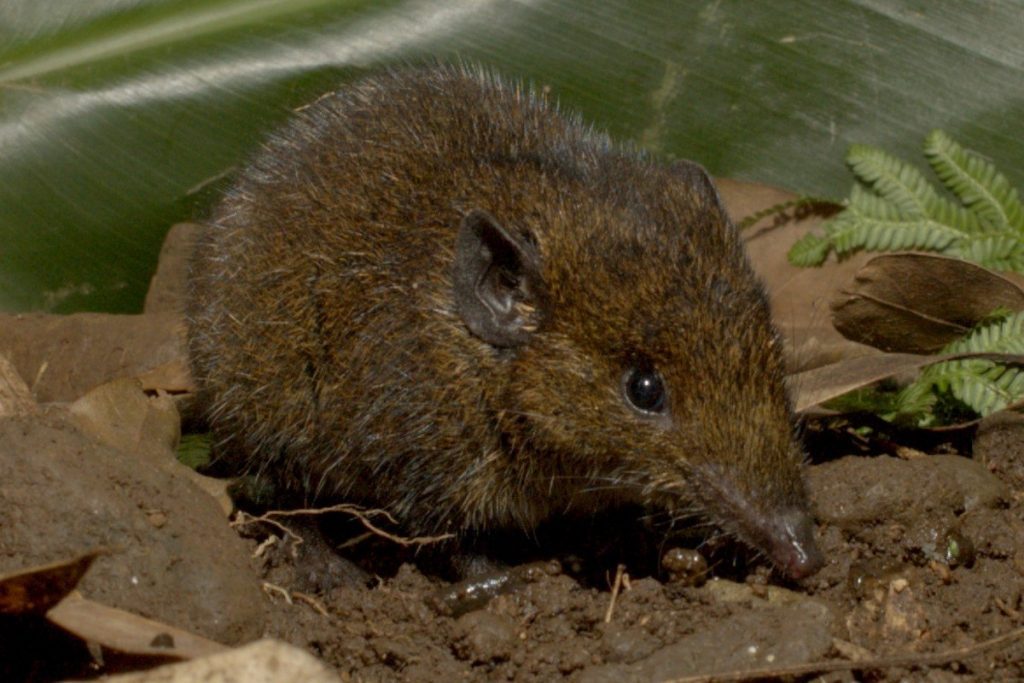
The upperparts of the short-tailed gymnure are reddish brown to dark brown, with a grey tinge. The underparts are light grey, with white-tipped hairs. It resembles a large shrew, with a long snout and a very short hairless tail. It also has rounded, leathery ears.
The head and body length is 12–14 cm and the tail length measures 2–3 cm.
It is active both day and night. The species lives in forests up to 3,000m, but sometimes in humid lowland forests. It feeds mainly on insects on the ground but it also takes some fruit occasionally. They normally don’t live any longer than 2 years.
The Asian house shrew (Suncus murinus), grey musk shrew, Asian musk shrew, money shrew, or simply house shrew is a widespread, adaptable species of shrew found mainly in South Asia but introduced widely throughout Asia and eastern Africa.

This species is found in forested areas, in agricultural lands, and in areas associated with human activity. S. murinus is found in many houses and businesses.
Nesting occurs wherever possible. In the forest/agricultural habitat, these shrews gather leaves and any other nesting material available, then find a hidden area (snag) in which to build the nest. In a house or business this species nests in dark hidden areas, and uses any type of loose material that can be found for nest construction.
The house shrew has a habit of moving quickly along the edges of the walls when it enters human habitations. As it runs it makes a chattering sound which resembles the sound of jingling money, which has earned them the name ”money shrew” in China. When alarmed, the house shrew makes an ear-piercing, high-pitched shriek, resembling the sound of nails scraping a chalkboard or a metal fork scraping glass, which repels house cats. Predators also leave the house shrew alone because of its musky smell and even when they catch one by mistake they will rarely eat it.
Another remarkable habit of this shrew (shared with the white-toothed shrews of Europe) is that it forms a ”caravan” with its young, that is, the young line up behind the mother and follow it while she walks. The first young will hold on to the mother’s fur with its teeth, and the subsequent young will do the same with the sibling in front of it.
It is often mistaken for a rat or mouse and killed as vermin. In general it is beneficial to humans because its diet consists mostly of harmful insects such as cockroaches, and even house mice.
Unlike rats, population levels of house shrews remain low. Despite its use as an insect control, it can be unpopular due to the strong odour of its droppings, which it may deposit in human dwellings behind kitchen cupboards, etc. It can also take to eating human food such as meat in kitchens, or dog or cat food. It is known to occasionally kill young chicks, making it unpopular with farmers, although rats probably kill more chicks, and more quickly.
Next time it’s bats, including one’s that perform fellatio and some of the biggest megabats…..
Sources: Wikipedia, Thai National Parks, Animal Diversity Web
More CNE Wildlife specials:

7 thoughts on “Cambodian Critters – Part One: The Furries”